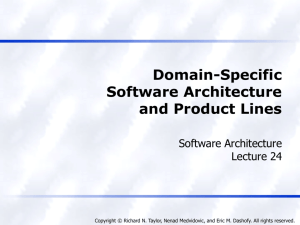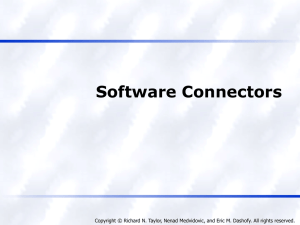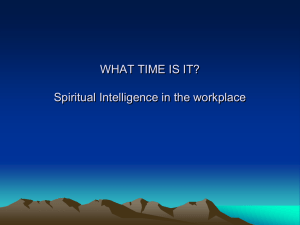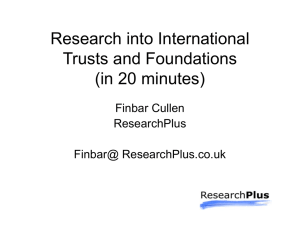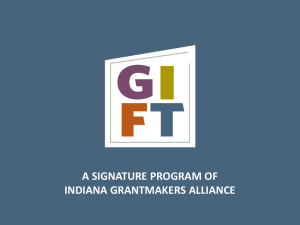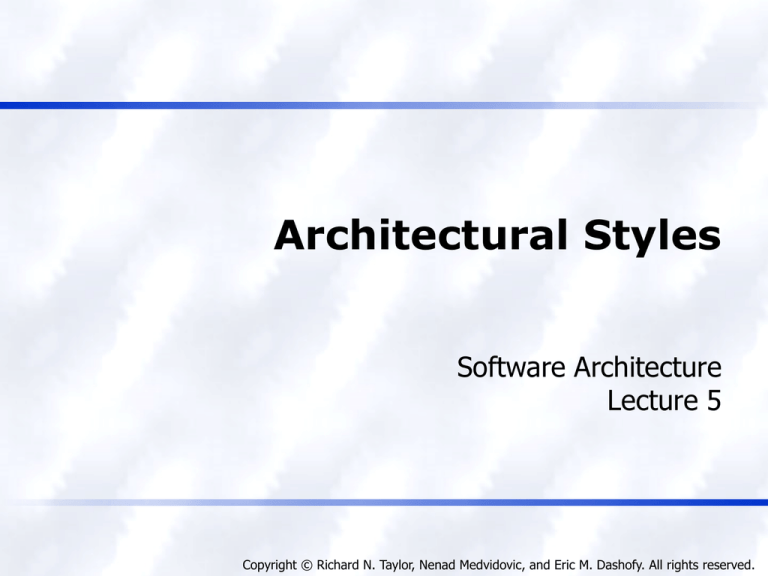
Architectural Styles
Software Architecture
Lecture 5
Copyright © Richard N. Taylor, Nenad Medvidovic, and Eric M. Dashofy. All rights reserved.
Software Architecture
Foundations, Theory, and Practice
Object-Oriented Style
Components are objects
Data and associated operations
Connectors are messages and method invocations
Style invariants
Objects are responsible for their internal representation
integrity
Internal representation is hidden from other objects
Advantages
“Infinite malleability” of object internals
System decomposition into sets of interacting agents
Disadvantages
Objects must know identities of servers
Side effects in object method invocations
2
Software Architecture
Foundations, Theory, and Practice
Object-Oriented LL
3
Software Architecture: Foundations, Theory, and Practice; Richard N. Taylor, Nenad Medvidovic, and Eric M. Dashofy; © 2008 John Wiley & Sons, Inc. Reprinted with permission.
Software Architecture
Foundations, Theory, and Practice
OO/LL in UML
4
Software Architecture: Foundations, Theory, and Practice; Richard N. Taylor, Nenad Medvidovic, and Eric M. Dashofy; © 2008 John Wiley & Sons, Inc. Reprinted with permission.
Software Architecture
Foundations, Theory, and Practice
Layered Style
Hierarchical system organization
“Multi-level client-server”
Each layer exposes an interface (API) to be used by
above layers
Each layer acts as a
Server: service provider to layers “above”
Client: service consumer of layer(s) “below”
Connectors are protocols of layer interaction
Example: operating systems
Virtual machine style results from fully opaque layers
5
Software Architecture
Foundations, Theory, and Practice
Layered Style (cont’d)
Advantages
Increasing abstraction levels
Evolvability
Changes in a layer affect at most the adjacent two
layers
Reuse
Different implementations of layer are allowed as long
as interface is preserved
Standardized layer interfaces for libraries and
frameworks
6
Software Architecture
Foundations, Theory, and Practice
Layered Style (cont’d)
Disadvantages
Not universally applicable
Performance
Layers may have to be skipped
Determining the correct abstraction level
7
Software Architecture
Foundations, Theory, and Practice
Layered Systems/Virtual Machines
8
Software Architecture: Foundations, Theory, and Practice; Richard N. Taylor, Nenad Medvidovic, and Eric M. Dashofy; © 2008 John Wiley & Sons, Inc. Reprinted with permission.
Software Architecture
Foundations, Theory, and Practice
Layered LL
9
Software Architecture: Foundations, Theory, and Practice; Richard N. Taylor, Nenad Medvidovic, and Eric M. Dashofy; © 2008 John Wiley & Sons, Inc. Reprinted with permission.
Software Architecture
Foundations, Theory, and Practice
Client-Server Style
Components are clients and servers
Servers do not know number or identities of clients
Clients know server’s identity
Connectors are RPC-based network interaction protocols
10
Software Architecture
Foundations, Theory, and Practice
Client-Server LL
11
Software Architecture: Foundations, Theory, and Practice; Richard N. Taylor, Nenad Medvidovic, and Eric M. Dashofy; © 2008 John Wiley & Sons, Inc. Reprinted with permission.
Software Architecture
Foundations, Theory, and Practice
Data-Flow Styles
Batch Sequential
Separate programs are executed in order; data is
passed as an aggregate from one program to the
next.
Connectors: “The human hand” carrying tapes
between the programs, a.k.a. “sneaker-net ”
Data Elements: Explicit, aggregate elements passed
from one component to the next upon completion of
the producing program’s execution.
Typical uses: Transaction processing in financial
systems. “The Granddaddy of Styles”
12
Software Architecture
Foundations, Theory, and Practice
Batch-Sequential: A Financial
Application
13
Software Architecture: Foundations, Theory, and Practice; Richard N. Taylor, Nenad Medvidovic, and Eric M. Dashofy; © 2008 John Wiley & Sons, Inc. Reprinted with permission.
Software Architecture
Foundations, Theory, and Practice
Batch-Sequential LL
Not a recipe for a successful lunar mission!
14
Software Architecture: Foundations, Theory, and Practice; Richard N. Taylor, Nenad Medvidovic, and Eric M. Dashofy; © 2008 John Wiley & Sons, Inc. Reprinted with permission.
Software Architecture
Foundations, Theory, and Practice
Pipe and Filter Style
Components are filters
Transform input data streams into output data streams
Possibly incremental production of output
Connectors are pipes
Conduits for data streams
Style invariants
Filters are independent (no shared state)
Filter has no knowledge of up- or down-stream filters
Examples
UNIX shell
signal processing
Distributed systems
parallel programming
Example: ls invoices | grep -e August | sort
15
Software Architecture
Foundations, Theory, and Practice
Pipe and Filter (cont’d)
Variations
Pipelines — linear sequences of filters
Bounded pipes — limited amount of data on a pipe
Typed pipes — data strongly typed
Advantages
System behavior is a succession of component behaviors
Filter addition, replacement, and reuse
Possible to hook any two filters together
Certain analyses
Throughput, latency, deadlock
Concurrent execution
16
Software Architecture
Foundations, Theory, and Practice
Pipe and Filter (cont’d)
Disadvantages
Batch organization of processing
Interactive applications
Lowest common denominator on data transmission
17
Software Architecture
Foundations, Theory, and Practice
Pipe and Filter LL
18
Software Architecture: Foundations, Theory, and Practice; Richard N. Taylor, Nenad Medvidovic, and Eric M. Dashofy; © 2008 John Wiley & Sons, Inc. Reprinted with permission.
Software Architecture
Foundations, Theory, and Practice
Blackboard Style
Two kinds of components
Central data structure — blackboard
Components operating on the blackboard
System control is entirely driven by the blackboard state
Examples
Typically used for AI systems
Integrated software environments (e.g., Interlisp)
Compiler architecture
19
Software Architecture
Foundations, Theory, and Practice
Blackboard LL
20
Software Architecture: Foundations, Theory, and Practice; Richard N. Taylor, Nenad Medvidovic, and Eric M. Dashofy; © 2008 John Wiley & Sons, Inc. Reprinted with permission.
Software Architecture
Foundations, Theory, and Practice
Mobile-Code Style
Summary: a data element (some representation of a
program) is dynamically transformed into a data
processing component.
Components: “Execution dock”, which handles receipt of
code and state; code compiler/interpreter
Connectors: Network protocols and elements for
packaging code and data for transmission.
Data Elements: Representations of code as data;
program state; data
Variants: Code-on-demand, remote evaluation, and
mobile agent.
21
Software Architecture
Foundations, Theory, and Practice
Mobile Code LL
Scripting languages (i.e. JavaScript,
VBScript), ActiveX control,
embedded Word/Excel macros.
Software Architecture: Foundations, Theory, and Practice; Richard N. Taylor, Nenad Medvidovic, and Eric M. Dashofy; © 2008 John Wiley & Sons, Inc. Reprinted with permission.
22
Software Architecture
Foundations, Theory, and Practice
Implicit Invocation Style
Event announcement instead of method invocation
“Listeners” register interest in and associate methods with
events
System invokes all registered methods implicitly
Component interfaces are methods and events
Two types of connectors
Invocation is either explicit or implicit in response to
events
Style invariants
“Announcers” are unaware of their events’ effects
No assumption about processing in response to events
23
Software Architecture
Foundations, Theory, and Practice
Implicit Invocation (cont’d)
Advantages
Component reuse
System evolution
Both at system construction-time & run-time
Disadvantages
Counter-intuitive system structure
Components relinquish computation control to the
system
No knowledge of what components will respond to
event
No knowledge of order of responses
24
Software Architecture
Foundations, Theory, and Practice
Publish-Subscribe
Subscribers register/deregister to receive specific
messages or specific content. Publishers broadcast
messages to subscribers either synchronously or
asynchronously.
25
Software Architecture
Foundations, Theory, and Practice
Publish-Subscribe (cont’d)
Components: Publishers, subscribers, proxies for managing
distribution
Connectors: Typically a network protocol is required.
Content-based subscription requires sophisticated connectors.
Data Elements: Subscriptions, notifications, published
information
Topology: Subscribers connect to publishers either directly or
may receive notifications via a network protocol from
intermediaries
Qualities yielded: Highly efficient one-way dissemination of
information with very low-coupling of components
26
Software Architecture
Foundations, Theory, and Practice
Pub-Sub LL
27
Software Architecture: Foundations, Theory, and Practice; Richard N. Taylor, Nenad Medvidovic, and Eric M. Dashofy; © 2008 John Wiley & Sons, Inc. Reprinted with permission.
Software Architecture
Foundations, Theory, and Practice
Event-Based Style
Independent components asynchronously emit and receive
events communicated over event buses
Components: Independent, concurrent event generators
and/or consumers
Connectors: Event buses (at least one)
Data Elements: Events – data sent as a first-class entity over
the event bus
Topology: Components communicate with the event buses,
not directly to each other.
Variants: Component communication with the event bus may
either be push or pull based.
Highly scalable, easy to evolve, effective for highly distributed
applications.
28
Software Architecture
Foundations, Theory, and Practice
Event-based LL
29
Software Architecture: Foundations, Theory, and Practice; Richard N. Taylor, Nenad Medvidovic, and Eric M. Dashofy; © 2008 John Wiley & Sons, Inc. Reprinted with permission.
Software Architecture
Foundations, Theory, and Practice
Peer-to-Peer Style
State and behavior are distributed among peers
which can act as either clients or servers.
Peers: independent components, having their own
state and control thread.
Connectors: Network protocols, often custom.
Data Elements: Network messages
30
Software Architecture
Foundations, Theory, and Practice
Peer-to-Peer Style (cont’d)
Topology: Network (may have redundant connections
between peers); can vary arbitrarily and dynamically
Supports decentralized computing with flow of
control and resources distributed among peers.
Highly robust in the face of failure of any given node.
Scalable in terms of access to resources and
computing power.
But caution on the protocol!
31
Software Architecture
Foundations, Theory, and Practice
Peer-to-Peer LL
32
Software Architecture: Foundations, Theory, and Practice; Richard N. Taylor, Nenad Medvidovic, and Eric M. Dashofy; © 2008 John Wiley & Sons, Inc. Reprinted with permission.
Software Architecture
Foundations, Theory, and Practice
Heterogeneous Styles
More complex styles created through composition of
simpler styles
REST (from the first lecture)
Complex history presented later in course
C2
Implicit invocation + Layering + other constraints
Distributed objects
OO + client-server network style
CORBA
33
Software Architecture
Foundations, Theory, and Practice
C2 Style
An indirect invocation style in which independent
components communicate exclusively through
message routing connectors. Strict rules on
connections between components and connectors
induce layering.
34
Software Architecture
Foundations, Theory, and Practice
C2 Style (cont’d)
Components: Independent, potentially concurrent
message generators and/or consumers
Connectors: Message routers that may filter,
translate, and broadcast messages of two kinds:
notifications and requests.
Data Elements: Messages – data sent as first-class
entities over the connectors. Notification messages
announce changes of state. Request messages
request performance of an action.
Topology: Layers of components and connectors,
with a defined “top” and “bottom”, wherein
notifications flow downwards and requests upwards.
35
Software Architecture
Foundations, Theory, and Practice
C2 LL
36
Software Architecture: Foundations, Theory, and Practice; Richard N. Taylor, Nenad Medvidovic, and Eric M. Dashofy; © 2008 John Wiley & Sons, Inc. Reprinted with permission.
Software Architecture
Foundations, Theory, and Practice
KLAX
37
Software Architecture: Foundations, Theory, and Practice; Richard N. Taylor, Nenad Medvidovic, and Eric M. Dashofy; © 2008 John Wiley & Sons, Inc. Reprinted with permission.
Software Architecture
Foundations, Theory, and Practice
KLAX in
C2
38
Software Architecture: Foundations, Theory, and Practice; Richard N. Taylor, Nenad Medvidovic, and Eric M. Dashofy; © 2008 John Wiley & Sons, Inc. Reprinted with permission.
Software Architecture
Foundations, Theory, and Practice
Distributed Objects: CORBA
“Objects” (coarse- or fine-grained) run on heterogeneous hosts,
written in heterogeneous languages. Objects provide services
through well-defined interfaces. Objects invoke methods across
host, process, and language boundaries via remote procedure calls
(RPCs).
Components: Objects (software components exposing services
through well-defined provided interfaces)
Connector: (Remote) Method invocation
Data Elements: Arguments to methods, return values, and
exceptions
Topology: General graph of objects from callers to callees.
Additional constraints imposed: Data passed in remote procedure
calls must be serializable. Callers must deal with exceptions that can
arise due to network or process faults.
Location, platform, and language “transparency”. CAUTION
39
Software Architecture
Foundations, Theory, and Practice
CORBA Concept and
Implementation
40
Software Architecture: Foundations, Theory, and Practice; Richard N. Taylor, Nenad Medvidovic, and Eric M. Dashofy; © 2008 John Wiley & Sons, Inc. Reprinted with permission.
Software Architecture
Foundations, Theory, and Practice
CORBA LL
41
Software Architecture: Foundations, Theory, and Practice; Richard N. Taylor, Nenad Medvidovic, and Eric M. Dashofy; © 2008 John Wiley & Sons, Inc. Reprinted with permission.

